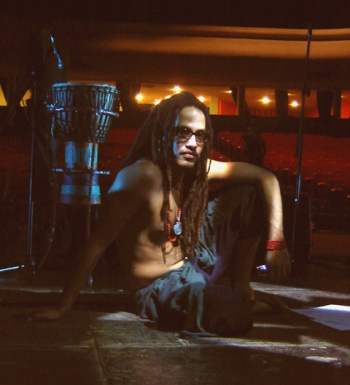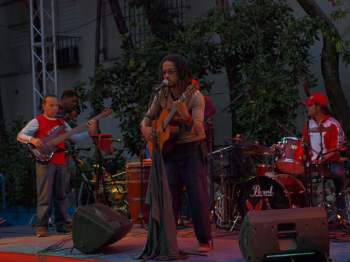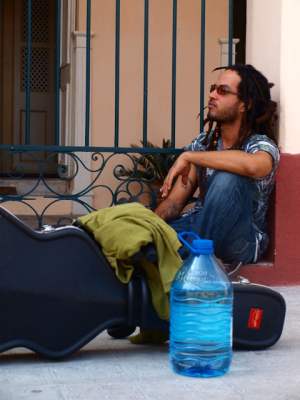Cuban Singer William Vivanco
Musical Bridge from Cuba*
Osmel Almaguer

HAVANA TIMES, May 18 — Musician William Vivanco, from Santiago de Cuba, began to become known in our country at the beginning of the millennium. His music captured the attention of children as well as the young and the not so young. His origin and youth allowed him to make music that’s catchy and full of freshness as it mixes several Latin American and Caribbean rhythms with the Anglophone essence of forms such as rap and the blues.
He sings songs that he himself composes while he plays the guitar accompanied by his band or by himself in performances all over the country and abroad.
His lyrics are sharp and fearless. Vivanco is clearly not detached from his reality; instead he uses it, as he says in one refrain, like “a bell at the tip of the whip.” He has recorded CDs Lo tengo to pensao (Fusion, 2002) and La isla milagrosa (Fusion, 2006) and El Mundo Esta Cambia’o, 2009.
“Cimarron” (from the CD Lo tengo to pensao)
Soy el cimarrón de la lejanía, tengo mi sazón, mi filosofía, pero por el salto de sus ojos blancos tendré que volver y me la llevaré, arriba, arriba, arriba, arriba, arriba, arriba, arriba, arriba.
Yo ofrendo la palma y le hago señales, rituales del alma que me reconocen, y ella bien se alegra cuando le ilumino el monte.
Me aprendí el lenguaje del cocuyo grande y aunque haya tormenta ya todos lo saben: haremos el amor con luces naturales: (aaah…).
Le guardé el arroyo de las campanillas, resané la cueva, quité filtración, marqué tu territorio, me crecí en la manigua y de los pelícanos aprendí canción: (pdrlala lalalalalá… lo tengo tó pensao, pdrlala lalalalalá…).
Soy el cimarrón y tengo la idea. Hoy hay titingó, temblor y batey. Si los rancheadores beben y se alegran, esta noche, esta noche, puede ser: (pdrlala lalalalalá… lo tengo tó pensao, pdrlala lalalalalá…).
When Vivanco appeared on the Cuban music scene in the early 2000s, he did it with that song – which was a solid hit. Everyone in the street was humming the sort of “anti-phonetic tune” that the author placed between his verses.

I saw him for first time on a musical program that used to be held every Sunday at noon where they would be present various musicians – sometimes talented, sometimes not. The originality in the mixture of ingredients that made up his song made people remember his name. In fact, a short while later we began to hear him on a more regular basis and with works that didn’t lower the standard set by “Cimarron.”
The fusion is evident. Vivanco is part of a generation of young musicians — especially those from Santiago de Cuba (I’m also thinking about the duo Postrova) — who were nurtured from multiple influences and breathed other rhythmic elements from the east side of the island and the Caribbean. These were perhaps distant in time and space but were related and interesting in the light of this postmodern epoch.
Like this, the stew of “Cimarron” contains reggae and Renaissance music, as well as timbers and voices that take us back to Black American music and perhaps even guajira tunes. The lyrics are equally impregnated with Afro-Cuban, religious and natural elements to craft a story that not only constitutes a beautiful parable of the fugitive slave, but it’s also a philosophy around this phenomenon, the ideal of escaping.
The song becomes a kind of call for “cimarronism” because each artist dialogues with their own generation and interacts with the problems characteristic of their society. Those that Vivanco makes allusion to are — without meaning to belabor the point — very well known by most everyone.
The story that he recounts in the words to “Cimarron” takes you back to the salve quarters in search for your mate, who you will lead in that escape. This former slave, now free, has achieved the highest degree of integration with nature as well as a high level of spirituality.

Up, up, up, up, are the hills where the slaves escaped to, but the idea of highness also relates to spirituality. What’s more, we can’t overlook the fact that this spirituality is impregnated with a tremendous amount of hedonism, that for which the escape itself is a sort of act of love (love for someone or something?) in which the man leads.
But this flight is still in the mind of the subject. Nighttime still hasn’t arrived, that protector, which will throw its dark cloak over the planters (paid to pursue the cimarron). The escape is in the mind of the free slave; but this one, instead of thinking of the woods, imagines crossing the sea, and his or her maroon society couldn’t simply be behind the nearest hill, but thousands of nautical miles away.
—
(*) A Musical Bridge from Cuba: This is an effort to find new bridges that promote communication between peoples of the diverse regions of the planet. I will be using simple narration in a series of articles to connect with those who are interested in the messages transmitted by Cuban songs, which due to their limited commercial potential and the difficulties posed by their translation, languish in a state of communicational stagnation – despite their being true jewels of Cuban culture.






Comments are closed.